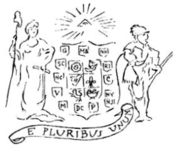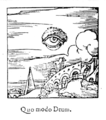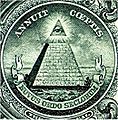- Eye of Providence
-
"All-seeing eye" redirects here. For other uses, see All-seeing eye (disambiguation).For Eye of God, see Eye of God (disambiguation).
Part of a series on God General conceptions Agnosticism · Apatheism · Atheism
Deism · Henotheism · Monolatrism
Monotheism · Panentheism
Pantheism · Theism · TranstheismSpecific conceptions Creator · Demiurge · Devil · Father
In particular religions
Great Architect · Monad · Mother
Supreme Being · Sustainer · The All
The Lord · Trinity · Tawhid · Ditheism
Monism · Personal · Unitarianism
Abrahamic (Bahá'í · Christianity
Islam · Judaism) · Ayyavazhi
Buddhism · Hinduism · Jainism
Sikhism · ZoroastrianismAttributes Eternalness · Existence · Gender
Names ("God") · Omnibenevolence
Omnipotence · Omnipresence
OmniscienceExperiences and practices Belief · Esotericism · Faith
Fideism · Gnosis · Hermeticism
Metaphysics · Mysticism
Prayer · Revelation · WorshipRelated topics Euthyphro dilemma · God complex
Neurotheology · Ontology
Philosophy · Problem of evil
Religion · Religious texts
Portrayals of God in popular mediaThe Eye of Providence (or the all-seeing eye of God) is a symbol showing an eye often surrounded by rays of light or a glory and usually enclosed by a triangle. It is sometimes interpreted as representing the eye of God watching over humankind (or divine providence).[1][2][3]
In the modern era, the most notable depiction of the eye is the reverse of the Great Seal of the United States, which appears on the United States one-dollar bill.
Contents
Religious use of the Eye
Imagery of an all-seeing eye can be traced back to Egyptian mythology and the Eye of Horus. It also appears in Buddhism, where Buddha is also regularly referred to as the "Eye of the World" throughout Buddhist scriptures (e.g. Mahaparinibbana Sutta) and is represented as a trinity in the shape of a triangle known as the Tiratna, or Triple Gem.[citation needed]
In Hinduism, the divine providence is associated with Lord Shiva, a major Hindu deity, who is one with great powers, yet lives a life of a sage and is known to keep himself intoxicated and meditating with bhang so that the world remains safe from his anger. He has an all seeing eye, the third eye on his forehead, that notices of everything that happens in the world, has an authority over death, rebirth and immortality.[citation needed] In Hinduism, the gods have a third eye which is described as being "all powerful and all seeing eye".[citation needed]
In Medieval and Renaissance European iconography, the Eye (often with the addition of an enclosing triangle) was an explicit image of the Christian Trinity. Seventeenth-century depictions of the Eye of Providence sometimes show it surrounded by clouds or sunbursts.
United States
In 1782, the Eye of Providence was adopted as part of the symbolism on the reverse side of the Great Seal of the United States. It was first suggested as an element of the Great Seal by the first of three design committees in 1776 and is thought to be the suggestion of the artistic consultant, Pierre Eugene du Simitiere.[4]
On the seal, the Eye is surrounded by the words Annuit Cœptis, meaning "He approves (or has approved) [our] undertakings", and Novus Ordo Seclorum, meaning "New Order of the Ages". The Eye is positioned above an unfinished pyramid with thirteen steps, representing the original thirteen states and the future growth of the country. The lowest level of the pyramid shows the year 1776 in Roman numerals. The combined implication is that the Eye, or God, favors the prosperity of the United States.
Perhaps due to its use in the design of the Great Seal, the Eye has made its way into other American seals and logos, notably the Seal of Colorado and DARPA's Information Awareness Office. It is also part of the City Seal of Kenosha, Wisconsin.
Freemasonry
 An early Masonic version of the Eye of Providence with clouds and a semi-circular glory
An early Masonic version of the Eye of Providence with clouds and a semi-circular glory
Today, the Eye of Providence is usually associated with Freemasonry. The Eye first appeared as part of the standard iconography of the Freemasons in 1797, with the publication of Thomas Smith Webb's Freemasons Monitor.[5] Here, it represents the all-seeing eye of God and is a reminder that a Mason's thoughts and deeds are always observed by God (who is referred to in Masonry as the Great Architect of the Universe). Typically, the Masonic Eye of Providence has a semi-circular glory below the eye. Sometimes the Eye is enclosed by a triangle.
Popular among conspiracy theorists is the claim that the Eye of Providence shown atop an unfinished pyramid on the Great Seal of the United States indicates the influence of Freemasonry in the founding of the United States. This was dramatized in the 2004 Disney film National Treasure. However, common Masonic use of the Eye dates to 14 years after the creation of the Great Seal. Furthermore, among the members of the various design committees for the Great Seal, only Benjamin Franklin was a Mason (and his ideas for the seal were not adopted). Indeed, many Masonic organizations have explicitly denied any connection to the creation of the Seal.[6][7]
Other selected uses of the symbol
- The Coat of Arms of Brasłaŭ, Belarus
- On the original publication of the Declaration of the Rights of Man and of the Citizen, which also borrows iconography of the Ten Commandments
- On the front page of the Serbian Constitution of 1835.
- The Kazan Cathedral, St. Petersburg, Russia
- The logo of the former Information Awareness Office, a division of DARPA within the United States Department of Defense
- Insignia of the UK Guards Division created in 1915
- The Steve Jackson Games logo
- Numerous video games contain depictions of the eye.
- Several college fraternities use the Eye of Providence in their coats of arms and/or badges, notably Delta Tau Delta, Phi Kappa Psi, Phi Delta Theta and Delta Kappa Epsilon.
- The seal of The University of Mississippi.
- The seal of The University of Chile.
- In the TV show "Then Came Bronson", the symbol appears on the tank of his motorcycle.
Currency
- United States one-dollar bill - as part of the Great Seal (see above)
- The 50 Estonian krooni note
- The 500 Ukrainian hryvnia note
Pictures
-
Eye of Horus, son of the chief deity of the ancient Egyptians.[8]
-
An alchemical woodcut showing the all-seeing eye of God floating in the sky.
-
An all-seeing eye that appears on the gate of Aachen Cathedral.
-
An all-seeing eye that appears on the pedestal decorations of Alexander Column.
-
An all-seeing eye that appears on the top of Declaration of Human Rights (1789), French Revolution.
-
An all-seeing eye that appears in a triangle at the facade of an Esoteric Christian Temple (1920), Mount Ecclesia.
-
The Eye of Providence can be seen on the reverse of the Great Seal of the United States, seen here on the US $1 bill
References
- ^ The eye as a Christian symbol, catholic-saints.com
- ^ Page on the Eye as a religious symbol from Religiousfacts.com
- ^ Freemasonry and the All-seeing Eye - from the Grand Lodge of British Columbia and Yukon website
- ^ The Great Seal of the United States booklet, published by US Dept. of State
- ^ Masonic Service Association webpage on the Eye in the Pyramid
- ^ Grand Lodge of British Columbia and Yukon, Anti-masonry Frequently Asked Questions
- ^ Pietre-Stones Review of Freemasonry, The "Masonic" One Dollar: Fact or Fiction? by W.Bro. David Barrett
- ^ Wörterbuch der ägyptischen Sprache 1, 268.13
External links
Categories:- Eye
- Masonic symbolism
- Pictograms
Wikimedia Foundation. 2010.











